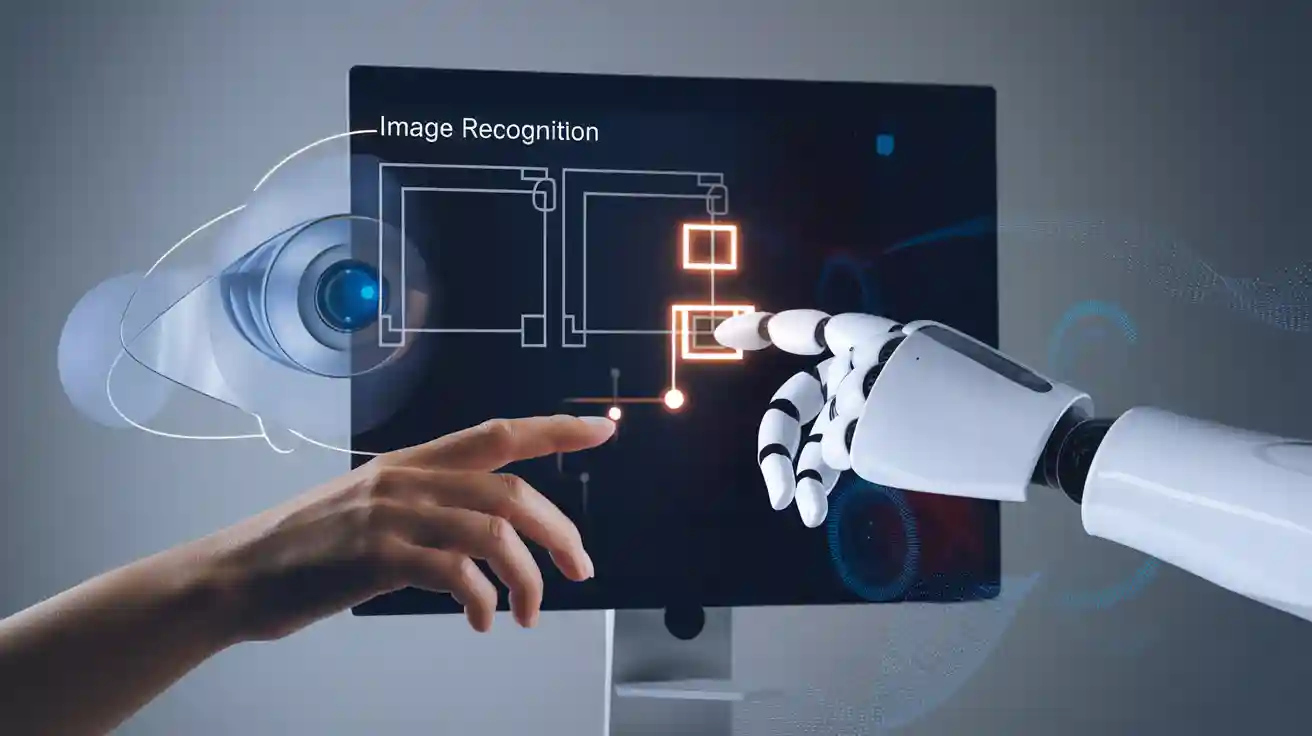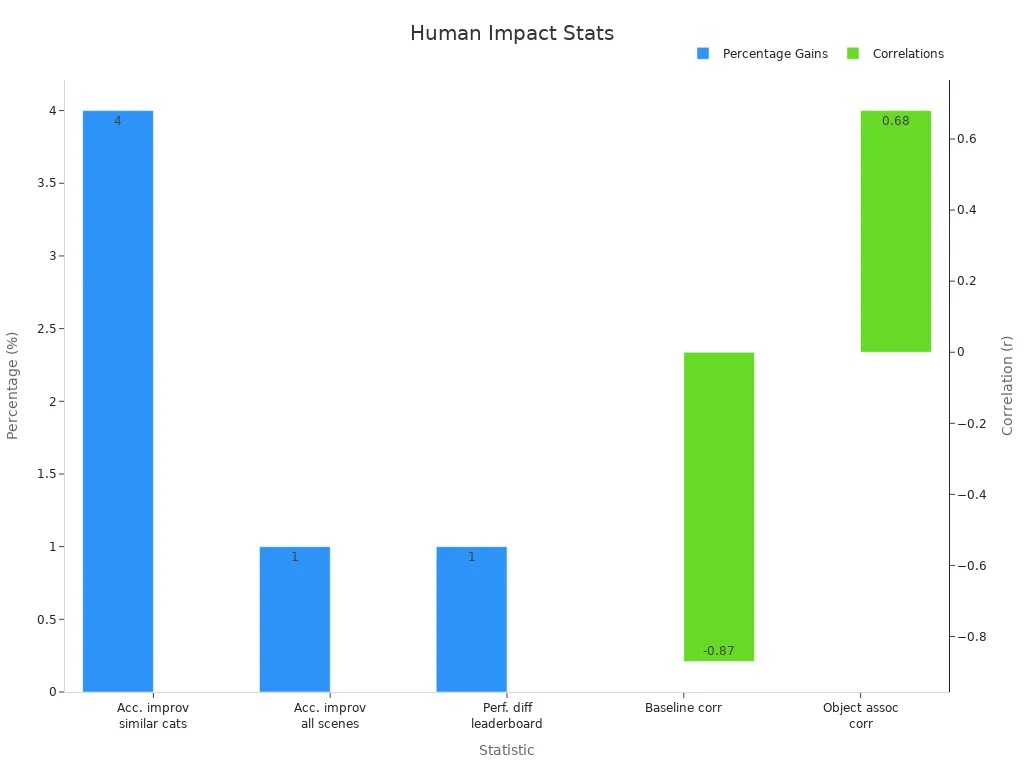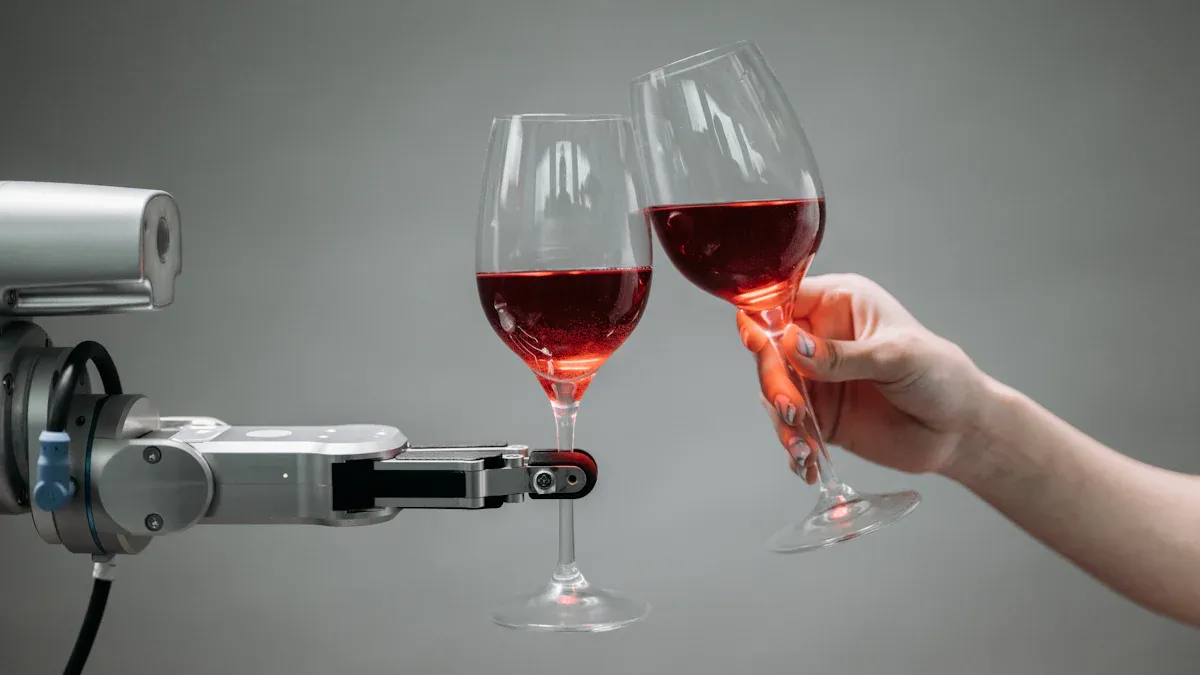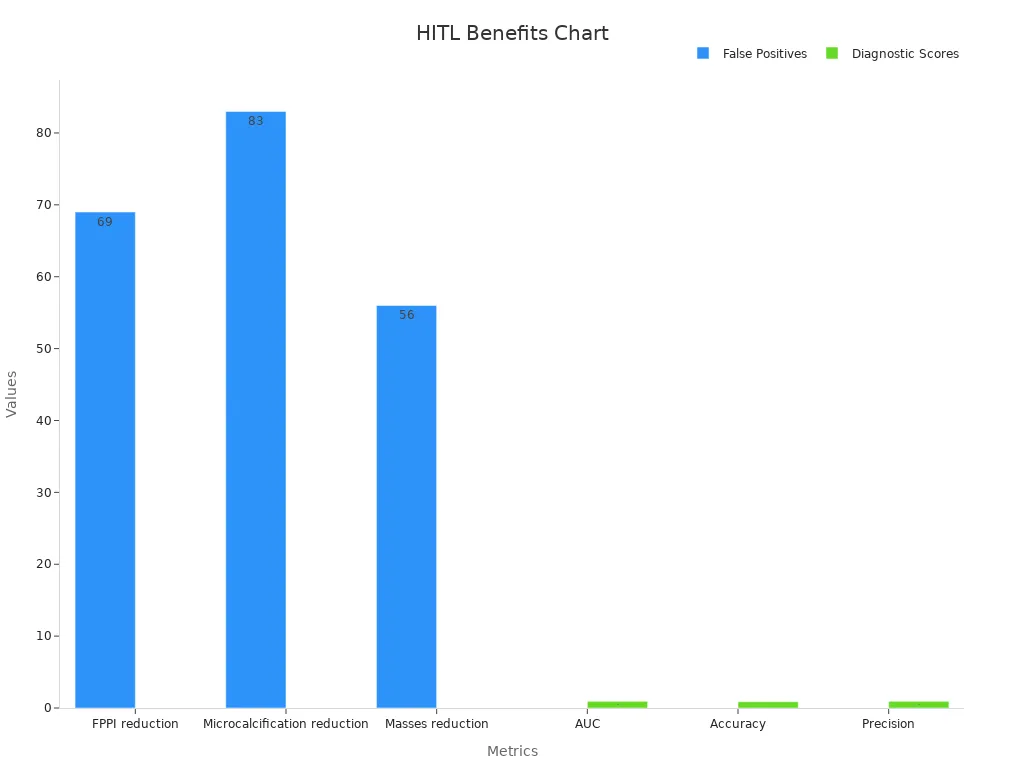
A human-in-the-loop machine vision system combines advanced ai and computer vision with direct human oversight. In these systems, people review, correct, and guide the intelligence of automated models. Human-in-the-loop processes remain vital because humans outperform ai in recognizing objects—humans reach 93% accuracy detecting cars, while computer vision models like CNNs achieve only 80%.  This gap highlights how human involvement boosts accuracy, transparency, and reliability. Human-in-the-loop also reduces bias and improves contextual understanding, making hitl essential for trustworthy intelligence. The hitl approach improves both ai and computer vision outcomes, making every human-in-the-loop machine vision system more effective.
This gap highlights how human involvement boosts accuracy, transparency, and reliability. Human-in-the-loop also reduces bias and improves contextual understanding, making hitl essential for trustworthy intelligence. The hitl approach improves both ai and computer vision outcomes, making every human-in-the-loop machine vision system more effective.
Key Takeaways
- Human-in-the-loop systems combine AI and human expertise to improve machine vision accuracy and reliability.
- Humans help by labeling data, correcting AI mistakes, and guiding model training, which boosts performance and trust.
- HITL is vital in fields like healthcare, autonomous vehicles, and quality control to reduce errors and handle complex cases.
- Continuous human feedback and iteration keep AI systems adaptable and effective in changing environments.
- Balancing automation with human oversight ensures safer, fairer, and more transparent AI decisions.
Human-in-the-Loop Machine Vision System
What Is Human-in-the-Loop?
A human-in-the-loop machine vision system brings together computer vision, artificial intelligence, and human expertise. In this system, people interact with machine learning workflows at different stages. They help prepare data, train models, and check results. This approach creates a feedback loop where humans and machines work together to improve outcomes.
Peer-reviewed research describes human-in-the-loop as an interactive framework within human–computer interaction. It allows human intervention during data preparation, model training, decision-making, and system monitoring. This process increases trust, explainability, and reliability in computer vision applications. Human-in-the-loop methods help address uncertainty and risk, especially in high-stakes fields like healthcare and manufacturing.
Human-in-the-loop means humans do not just watch. They guide, correct, and teach the system. This makes the intelligence behind computer vision more trustworthy and accurate.
Technical literature explains that human-in-the-loop involves humans providing high-quality training data, scoring AI outputs, and correcting errors. They test models and influence simulation outcomes. This process leads to smarter and more reliable artificial intelligence. Examples include autonomous vehicles learning from human drivers and smart devices improving with user feedback. Human-in-the-loop also supports digital accessibility by allowing manual checks for people with disabilities.
Why Use HITL?
Organizations use hitl in computer vision to boost accuracy, reduce bias, and ensure reliable results. Machine learning workflows benefit from human oversight because people can spot errors that algorithms miss. In healthcare, hitl systems help validate AI decisions. Studies show that AI can lower medical billing errors and claim denials, but human oversight remains vital for safety and quality. Doctors and nurses use hitl to catch mistakes and keep patient care at a high standard.
In manufacturing, hitl machine vision systems detect defects in real time. These systems find micro-defects that humans cannot see, but human oversight is still needed for complex cases. Workers review flagged items and help the system adapt to new products. This teamwork improves product quality and workplace safety.
Human-in-the-loop also plays a key role in other fields:
- In customer service, chatbots handle simple questions, but humans step in for complex issues.
- In recruitment, human auditing helps remove bias from AI hiring tools.
- In autonomous vehicles, human oversight ensures safety and accountability.
- In content moderation, humans and AI work together to filter harmful material.
Machine learning workflows that include hitl become more robust. Humans provide feedback, correct mistakes, and help the system learn from new data. This process ensures that computer vision and artificial intelligence systems remain accurate, ethical, and adaptable.
Tip: Combining human-in-the-loop with computer vision and machine learning creates a system that learns faster and makes fewer mistakes.
A human-in-the-loop machine vision system stands out because it does not rely only on algorithms. It uses human intelligence to guide, check, and improve every step. This approach leads to better results in fields where accuracy and trust matter most.
How HITL Works
Data Labeling and Annotation
In a human-in-the-loop system, people play a key role in labeling and annotating images or videos. This step forms the foundation for machine learning and supervised learning. Accurate data labeling helps algorithms learn to recognize patterns and objects. Teams use several metrics to measure the quality of this work:
- Cohen’s kappa checks how much two people agree on labels, even by chance.
- Fleiss’ kappa extends this to groups.
- Krippendorf’s alpha works well for incomplete data.
- The F1 score balances precision and recall to show annotation quality.
- Model accuracy improvement shows how better labeling boosts model performance.
- Human-machine agreement measures how often people and models agree.
- Efficiency metrics track how much human effort is saved.
- Feedback quality looks at the value of human feedback in the loop.
These metrics help teams build strong training data for machine learning and hitl systems.
Model Training and Validation
During model training, humans and machines work together to improve results. People review outputs, correct mistakes, and guide the training process. This approach, called collaborative active learning, helps supervised models learn faster and more accurately. In real-world cases, human-in-the-loop validation has improved model performance and trust. For example, in healthcare, joint human-AI decision-making sometimes leads to better results than AI alone. Human experts help refine features and correct predictions, making model training more reliable. This process also supports knowledge retention and efficiency.
Feedback and Iteration
A continuous feedback loop stands at the heart of hitl systems. After each round of training, humans review results and provide feedback. The system then retrains using this new information. Research shows that iterative feedback and retraining cycles boost model performance over time. This process helps models adapt to new data and changing environments. Teams use feedback to update training data, adjust objectives, and fine-tune parameters. The result is a machine learning system that stays accurate, reliable, and ready for real-world challenges.
Note: Ongoing human feedback and iteration keep hitl systems effective, especially when data or tasks change quickly.
Applications of HITL

Medical Imaging
Medical imaging stands as one of the most important real-world applications for hitl. Doctors and radiologists use hitl systems to improve image classification and object detection in X-rays, MRIs, and CT scans. These systems help with the recognition of tumors, fractures, and other abnormalities. When ai models work together with human experts, they reduce errors and speed up diagnosis. Studies show that hitl can lower false positives and improve accuracy in medical image classification.
| Metric / Outcome | Result / Improvement | Context / Study Detail |
|---|---|---|
| Reduction in false-positive marks per image (FPPI) | 69% reduction | AI-CAD system vs traditional CAD software |
| Reduction in false positives for microcalcifications | 83% reduction | AI-CAD system performance in identifying microcalcifications |
| Reduction in false positives for masses | 56% reduction | AI-CAD system performance in identifying masses |
| Estimated reduction in radiologist case reading time | 17% reduction | Efficiency gain due to AI-CAD reducing false positives |
| AUC (Area Under Curve) in musculoskeletal radiograph abnormality detection | 0.93 | Calibrated ensemble deep learning model outperforming individual models and expert radiologists |
| Accuracy in musculoskeletal radiograph abnormality detection | 0.87 | Same ensemble model study |
| Precision in musculoskeletal radiograph abnormality detection | 0.93 | Same ensemble model study |

A recent study compared a medical imaging-specific ai model, KARA-CXR, with a general large language model. KARA-CXR achieved a non-hallucination rate of 75%, while the general model reached only 38%. This result shows that hitl systems designed for medical imaging provide better recognition and reliability.
Autonomous Vehicles
Autonomous vehicles rely on hitl for safe navigation and decision-making. These vehicles use computer vision for object detection and image classification to recognize pedestrians, traffic signs, and other vehicles. Human supervisors monitor the system and step in when the ai faces uncertain situations. This approach helps prevent accidents and improves trust in self-driving technology. Hitl also supports continuous learning by allowing humans to label new data and correct mistakes. The combination of human feedback and ai leads to better recognition and safer real-world applications.
Quality Control
Factories and production lines use hitl to improve quality control. Automated systems use object detection and image classification to spot defects in products. However, some defects are hard to recognize, especially in complex backgrounds. Human inspectors review flagged items and provide feedback to the ai. This teamwork helps the system learn from new examples and adapt to changing products. In security inspection, hitl combines deep learning models with human decision-making to detect contraband and improve accuracy. The approach addresses challenges like limited training data and keeps inspectors alert, reducing false positives and improving recognition.
Tip: Teams that use hitl in quality control see fewer errors and higher product standards. Human oversight ensures that computer vision systems remain reliable in real-world applications.
Benefits and Challenges
Benefits of Human-in-the-Loop
Human-in-the-loop (HITL) systems bring many advantages to machine vision. These systems combine the strengths of artificial intelligence and human expertise. Teams use HITL to enhance accuracy and improve model performance in real-world tasks. For example, IBM Watson Health uses AI to analyze medical images, but human experts review the results. This process increases diagnostic accuracy and transparency. In healthcare, AI-driven pneumonia detection improved early diagnosis by 12% when radiologists provided human oversight. Tesla Autopilot uses HITL by allowing drivers to override the system in unpredictable situations, which keeps driving safe and adaptable.
HITL also helps in other fields. Facebook uses both automated tools and human reviewers to moderate content. This approach maintains ethical standards and trust. In financial services, AI-augmented loan approvals reduced processing time by 60% while keeping predictive accuracy high through targeted human intervention.
Key benefits of HITL in machine learning and machine vision include:
- Improved accuracy through human feedback and annotation.
- Increased adaptability to new situations and user needs.
- Better handling of complex or rare cases.
- Continuous feedback loops that help models learn and improve.
- Reduction of bias in AI outputs.
- Higher safety and precision in critical environments.
- Enhanced transparency and explainability of decisions.
- Quality assurance and oversight for reliable results.
A recent study on HITL cyber–physical systems found that involving humans throughout the process boosts system performance and user experience.
Tip: HITL systems help organizations reduce errors, adapt to edge cases, and build trust in AI-powered solutions.
Challenges of HITL
Despite the benefits, HITL systems face several challenges. Integrating human feedback into machine learning workflows can slow down training. Real human input takes time, which may delay improvements in model performance. Some organizations use simulated humans to speed up the process, but this method has limits.
Researchers have identified other challenges in HITL machine vision systems:
- Complexity in ethical decision-making and safety.
- Security risks and the need for strong protocols.
- Difficulty in evaluating HITL algorithms, as results can be subjective.
- Regulatory requirements for privacy, safety, and accountability.
- Managing bias introduced by human input.
- Ensuring timely and effective human intervention during critical events.
In autonomous vehicles, for example, HITL systems must balance safety, reliability, and quick decision-making. Regulatory frameworks are needed to define responsibilities and protect privacy. Teams must also develop agent-specific protocols to improve the quality of human feedback.
Note: HITL systems require careful planning to address these challenges and maintain high standards in machine vision applications.
Best Practices
Balancing Automation and Oversight
Organizations achieve the best results in machine vision by carefully balancing automation with human oversight. Industry leaders recommend different patterns of human involvement based on the complexity and risk of each task:
- Human-in-the-loop: Humans make final decisions after reviewing automated suggestions. This pattern works well in healthcare and other fields where ethical choices matter.
- Human-over-the-loop: Humans monitor automated systems and step in only when needed. This approach increases efficiency while keeping oversight.
- Human-out-of-the-loop: Automation handles simple, repetitive tasks alone. However, this method can lead to unchecked errors in complex situations.
Teams often start automation with well-defined tasks and then scale up as confidence grows. They maintain clear paths for escalation and feedback, so issues get addressed quickly. Human judgment remains essential for setting strategies, handling ethical questions, and meeting new regulations. For example, in healthcare, human experts review AI decisions in complex cases to ensure safety and accuracy. AI systems can process large datasets, but they sometimes make mistakes with multi-step tasks. Human oversight helps verify results and keeps the system trustworthy.
Tip: Automation should support, not replace, human judgment—especially when decisions affect people’s lives.
Ensuring Data Quality
High-quality data forms the backbone of any successful human-in-the-loop system. Teams use several strategies to ensure reliable data and improve outcomes. In healthcare, radiologists review AI results for low-confidence cases, which leads to a 37% reduction in diagnostic errors. In financial services, human review of AI loan approvals reduces demographic approval disparities by 28%. Content moderation teams see a 45% improvement in accuracy and consistency when humans check borderline cases.
| Application Domain | HITL Strategy Description | Quantitative Outcome |
|---|---|---|
| Healthcare | Radiologists review AI low-confidence diagnostic cases | 37% reduction in diagnostic errors |
| Financial Services | Human review of AI loan approvals for bias and edge cases | 28% reduction in demographic approval disparities |
| Content Moderation | Human moderators review borderline AI content classifications | 45% improvement in moderation accuracy and consistency |
Human-in-the-loop systems also use statistical and deep learning models to monitor and adapt to new data. Human feedback helps these systems stay accurate and reliable, even as tasks or environments change.
Human-in-the-loop systems blend automation with human expertise to make machine vision more accurate and reliable. By adding human feedback, these systems handle complex cases and improve over time. HITL methods help reduce errors, address bias, and adapt to new challenges. Experts expect HITL to play a bigger role as AI grows.
HITL continues to shape the future of machine vision by combining human insight with smart technology.
FAQ
What does "human-in-the-loop" mean in machine vision?
Human-in-the-loop means people help computer vision systems by checking, correcting, or guiding the results. This teamwork helps the system learn and make fewer mistakes.
How do humans improve machine vision accuracy?
Humans spot errors that computers miss. They label images, review results, and give feedback. This process helps the system learn from real-world examples and become more accurate.
Where do companies use human-in-the-loop systems?
Companies use these systems in healthcare, self-driving cars, factories, and online content moderation. Human help makes sure results stay safe, fair, and reliable.
Can human-in-the-loop systems reduce bias?
Yes. People can notice unfair patterns in data or results. They correct these issues, which helps the system treat everyone more fairly.
Do human-in-the-loop systems slow down automation?
Sometimes. Human review takes extra time. However, this step helps catch mistakes and keeps the system safe, especially in important tasks.
See Also
Understanding Pixel-Based Vision Technology For Today’s Uses
Comparing Firmware Vision Solutions With Conventional Methods
Investigating The Role Of Artificial Data In Vision Systems
A Detailed Look At Cameras Used In Vision Systems
Complete Overview Of Vision Technology In Industrial Automation









